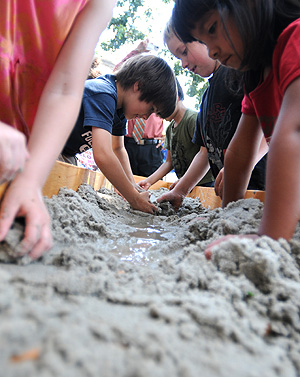Table of Learning
Freshmen Engineers Build It, Children Learn Hydrology From It
August 18, 2009
By Russ L. Hudson

Children dig into the stream table, damming the water and watching it transform the sand. Photo by Kelly Lacefield
By the time the 30-minute stream table unveiling was completed at the Cal State Fullerton Children’s Center May 19 it had taught all the students something.
The college freshmen who designed and built the table knew they had absorbed a lot about the craft of engineering. The gaggle of laughing, squealing three- to six-year-olds knew it was was fun to dam the stream with scooped sand to create islands then watch as the stream eroded them.
The nine freshmen engineering students from Freddi Jo Bruschke’s Freshman Program University 100 class called it a learning experience and, after seeing the children’s unbridled enthusiasm, one they’ll always remember.
Bruschke and teachers at the center, which cares for 155 children ranging from four months to six years, determined that the table would be a valuable long-term science-learning tool for the children. She wrote the proposal for the stream table and won approval from Freshman Program. Students in the voluntary Freshman Programs — which offers classes, learning resources and advising to entering university students — must complete projects as part of the program.
The 15-foot-long stream table of heavy-duty plywood changes angles twice to alter the water’s course, and each bend has a slight drop. The table’s two-foot height makes it accessible to small children, and 250 pounds of sand spread the length of the table provide the “land form” the water runs through and reshapes. An electric pump sends the water back from the hooded catch tank under the low end of the table to the high end to run down the stream bed again.
Starting From Scratch
The college students figured out on their own how to meet the requirements. It wasn’t easy.
“Some of us even had to figure out basic woodworking, how to use tools, because we hadn’t before,” said civil and environmental engineering major Annette Ruiz of Hawthorne. “We also had to think in terms of sizing it for little kids, not adults.”
Mechanical engineering major Kyle Nakayama of Monterey Park became an unofficial adviser to his peers because he had some woodworking experience. “But, still,” he said, “this was more complicated than what I’d done. Like having to maintain a grade for the water flow, especially when we had to install the table on uneven ground. We also had to make it modular.”
Easy release hinges connect the tables’ three sections which are sealed by rubber gaskets to prevent leakage. That allows some flexibility for uneven ground and easier portability.
“There are other technical problems you expect, like how to determine which is the best pump and how to catch the water and send it safely and efficiently back through the return system,” said mechanical engineering major Jessica Frasher of Landers. “Then you come across things that you didn’t expect. You learn to solve problems as you go.”
Suzanne Moubayed of Mission Viejo, a civil engineering major, liked the collaboration. “I learned that others can learn from your skills and knowledge. Not only did I learn skills, too, but I learned more about strategy and problem solving."
Also on the team were Charles Askar of Apple Valley, Aaron Calderon of Buena Park, Alan Dang of El Monte, James Esquivel of Lake Forest and Alex Lemmon of Irvine.
Applying Classroom Lessons
The idea is for the students to take what they learn in engineering classes and apply it to their project, said Ricardo Lopez, retention coordinator for the College of Engineering and Computer Science and co-instructor with Bruschke.
“They also have to teach themselves as they go, which is a part of it.” Lopez said, “They had to put in the 20 hours each to make this happen. They put in more time than that. They wanted this project to really work out for the kids.”
“By the end of the semester," Bruschke said, "they became a working team of engineers, united by a sense of their collective ownership of the project.”
Projects like this help freshmen assess whether they have chosen an appropriate field of study.
"Especially in engineering, undergraduates must trudge through introductory math and science for quite some time before they are ready to tackle actual engineering projects,” said Bruschke. “They got a head start with this.”
Just as important was a life lesson, she added. “I think many of the students were surprised to find that they liked the feeling of giving something to others. They also developed an awareness of their own abilities. Some students were surprised to find that they already possessed skills that were valuable to others, and that their recent experiences could be an inspiration to freshmen following behind them.”
Betsy Gibbs, Children's Center director, thanked the young engineers, noting that “these children will play and learn from this for a long, long time. They’ll barely be aware they’re learning, but the table will keep teaching like this for years.”
Media Contact:
Russ L. Hudson, Public Affairs, 657-278-4007, or rhudson@fullerton.edu

